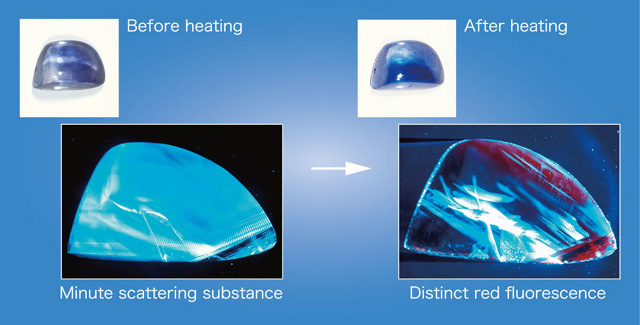|
・ Features in Raman spectroscopic analysis
Microscopic Raman spectroscopy has advanced spacial resolution and it is effective to identify inclusions in gemstones non-destructively. Hence it can help identification of locality in ruby or sapphire and also it becomes useful indirectly in identifying heated / unheated status. It can be used for determination of heat treatment directly (figure 14) because the Raman spectrum from a zircon crystal in corundum is known to be changed by heating process. The spectrum observed after heating is actually assumed to be derived from resolving of zircon crystal into SiO2 and ZrO2 caused by photoluminescence.
・ Features in Laser tomography Laser tomography can observe and record internal tomograph at a certain level in a sample by slowly scanning with a narrowed laser beam. Whit this technique, unevenness of a crystal can be observed three dimensionally. Various wavelengths can be selected for a laser source and for this tomography argon ion laser (blue ray) of wavelength at 488nm is suitable. This tomography can clearly detect scattering image that is difficult to find under a microscope such as crystal defect, and moreover, it is expected to observe fluorescent image (of longer wavelength than blue such as green, yellow, orange or red colour) excited by the argon laser (blue ray) (figure 15).
From our experiments on heating and practical experiences to date at GAAJ laboratory, it has been proved that dislocation (linear defect) generated by heating can be easily detected by laser tomography, and also that blue sapphire tents to increase the intensity of red fluorescence by heating (figure 16).
Figure 17 shows typical tomographic images of unheated and heated ruby from Mong-Hsu, which is one of the most marketable gems in Japan. Sector boundary of unheated ruby on the tomograph is indistinct while that of heated stone is sharp.
Figure 18 shows a tomographic image of blue sapphire which heated by a typical geuda stone. Very sharp sector boundary that is not seen in unheated stones is captured as a fluorescent image.
♦Limitation in Identification of Heated / Unheated Status On rubies from Mong-Hsu district in Myanmar, some controversy was raised several years ago about identification of so-called low-heating process. Around that time a large number of rubies from Mong-Hsu district with identification reports issued by a laboratory overseas stating that the stones showed “no indication of heating” were brought into Japanese market. However, some of them were actually heated at low temperature (under 1000ºC?). Ruby from Mong-Hsu district contains deep-blue section in the centre and heat treatment is generally performed to remove this blue section. Therefore stones showing such blue colour zone had initially been assumed as unheated. However the succeeding research proved that this blue colour zone does not disappear by low-temperature heating at under 1000ºC. GAAJ laboratory demonstrated that identification of ruby from Mong-Hsu that had been exposed to heat over 500〜600ºC was possible by infrared spectral analysis (FTIR) (figure 18). Observation by laser tomography has potential for detection of low temperature treatment that is almost at detection limit or even under this with other techniques, and we have been carrying on ceaseless research. Laboratory Manual Harmonization Committee* (LMHC) is working on adjusting words and terms at laboratories in the world at the moment, and trying to prevent different identification results from occurring between laboratories by setting guidelines for detection of heated / unheated status on corundum. Collaborative research, information exchange and interaction of practical experience between international laboratories have been required more than ever in order to identify geographic origin of or treatment in a gemstone. We must expend effort to impart scientific credible assurance and confidence to gemstone industry and consumers. ♦ Summary Detailed observation of internal features is very important to identify heated or unheated ruby and sapphire. As many crystal inclusions have lower melting point than corundum, they may be fused or discoloured by heating. Spectral analyses in UV-visible and infrared regions also give us important information on detection of heated / unheated status in corundum. Especially in infrared spectral analysis, different features are observed in corundum of different origin, so that knowledge of geographic origins and analytical ability of an operator are essential. Raman spectroscopic analysis is useful to identify heated / unheated status both directly and indirectly. Laser tomography is effective to detect heated / unheated status, especially on ruby from Mong-Hsu or sapphire produced from heated geuda this technique has a possibility to detect low temperature treatment that is almost at or even under the detection limit in other methods. *LMHC consists of the seven laboratories world wide: AGTA-Gem Testing Center (USA.), CISGEM (Italy), Gemmological Association of All Japan (Japan), GIA-Gem Trade Laboratory (USA), GIT-Gem Testing Laboratory (Thailand), G?belin Gem Lab (Switzerland) and SSEF Swiss Gemmological Institute (Switzerland). |
||||||||||||||||||||
|




